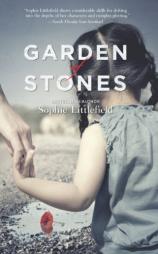Interview: March 22, 2013
Bookreporter.com’s Melanie Smith talks to Sophie Littlefield, whose latest novel, GARDEN OF STONES, revolves around a mother who makes the ultimate sacrifice for her daughter in the dark days of World War II. In this interview, Littlefield discusses her motivation for writing the book, the fascinating mother-daughter relationship that is central to the plot, and the novel’s vividly described settings. She also shares much about her firsthand experiences and perceptions in visiting Manzanar, how she went about understanding the psychological aspect of captivity for the Japanese Americans, and why she incorporated taxidermy into the storyline.
Bookreporter.com: Reading GARDEN OF STONES, my first thought was that the concentration camps that had been sanctioned on American soil by the U.S. government during World War II are a blemish on our history. What was your motivation for writing the book? Do you feel that this part of history seems under-represented or ignored by historians and institutions?
Sophie Littlefield: I didn’t set out to address a perceived lack of attention to an issue, even though it’s true that the internment of Japanese-Americans is a woefully under-told chapter of our history. I had never written historical fiction, but when I first learned about the camps, I knew that I wanted to set a story there.
I tend to write about settings in which conflict is inherent and inevitable --- in which any character would be forced to react, change, adapt, fight, struggle, etc. I’ve never been moved to write about war because the scale of the conflict exceeds the individual. But internment by its nature is personal. Its twin themes of loss and shame are experienced by every individual both privately and within each concentric circle of relationship: family, community, racial identity, national identity. A storyteller cannot ask for more: we focus on ordinary people in extraordinary circumstances, and an internment camp --- by stripping people of their belongings, routine, dignity, comforts, and identity --- is a most extraordinary circumstance for the entire cast of characters.
BRC: This character-driven novel focuses on weighty issues with tact and sensitivity. How did you go about planning such a complicated writing project?
SL: I wish I could say that I planned with care, but the opposite is true: I wrote a hulking, undisciplined first draft, and then the book went through several deep revisions. Many thousands of words, and a number of characters, were cut. It took the insight and the steady scalpel of my editor, Erika Imranyi, to compel me to make some of the more drastic changes, but I slowly came to understand that every element of the book had to illuminate, reflect or echo the internment experience in some way. It may not always be clear to the reader, but each character and scene in the book is intended to do just that.
You may be thinking that it would be a lot more efficient if I could settle on the shape of a book before throwing the word-equivalent of many pounds of wet spaghetti at the wall. And that is certainly true, but this appears --- after a dozen books --- to be my process: write first, refine later.
BRC: The mother-daughter relationships in the book were fascinating, particularly the unique approaches of one mother and daughter’s perceptions and reactions to a stressful situation. The way Lucy Takeda’s life plays out makes one wonder if any personal attitudes or personalities --- either hers or her mother’s --- contributed to the family’s difficult experiences. What messages about these relationships were you trying to portray?
SL: The mother-daughter relationship has figured large in several of my books already, and I am sure it will continue to be central to my work. As the mother of a nearly-grown girl, I can tell you that I’ve been overwhelmed with both the speechless joy and the bottomless despair of this most important relationship.
Miyako and Lucy are not modeled after anyone in my life, but I was very sure of who they were before I began writing their story. Their reactions, choices and emotions are as true to their character as I was able to make them. Lucy is pragmatic, stubborn and independent, which helps her survive the hardships of her life; her mother was weaker in some ways, but also passionate and aesthetically sensitive. They loved each other enough to sacrifice for each other, but the ways in which each chose to do so reflect these differences.
BRC: How did you come up with your ideas for the novel’s vividly described settings?
SL: California’s Inyo Valley must have wished to hold onto this chapter of its history because it still bears the traces of internment. Not only does the Manzanar Historic Site offer accurately recreated barracks and other camp buildings, but traces of the original camp are still there. The cemetery, with its pyramid monument created by an interned stonemason, looks much the same today as it must have then. The two guard shacks still stand, oblivious to the passage of time.
I gathered all the photos and artwork that I could find, including the work of Ansel Adams and Dorothea Lange, as well as artistic renderings of camp life in every medium, created by those who lived in Manzanar and the other internment camps. Photographic reproductions hung on the walls of my office as I worked on the book, and many of the images are indelibly printed on my mind.
BRC: What can you share about your research? What were your first-hand experiences and perceptions in visiting Manzanar?
SL: I relied on fictional accounts of internment; historic and photographic accounts; and blueprints, camp newsletters and documents issued by the War Relocation Authority, that I found on the Internet. I was pretty well versed in the history of internment by the time I went to Manzanar, but I still wasn’t prepared for the emotional impact of the experience. I walked slowly through the ruins, literally stumbling over the traces of rock gardens: orderly rows of smooth stones set into the desert earth, grown over now with scrub. I had read about the old men who, too infirm to work in the camp gardens, would pass the time searching for the best stones. I was moved by the endurance of human will to create beauty even in the harshest conditions.
BRC: How did you go about understanding the psychological aspect of captivity for these Japanese Americans?
SL: Personal accounts of internment that were written years after the war reflect emotions that internees were not able to express at the time, due to fear, trauma and cultural beliefs about public expression of grief, anger and shame. I also read accounts written by white staff, largely teachers recruited to work in the camps alongside their Japanese-American colleagues who volunteered for the role. Several wrote of how their perspective changed from the time they came to the camps to many years later when they were able to see the era in a larger historical context. It was a very effective means for me to understand how government propaganda, social pressures and sensationalist reporting combined to create a culture in which it was easy to believe that internment was not only conscionable but necessary.
BRC: Can you give us some information on President Roosevelt’s decision to sign Executive Order 9066, including the factors leading to its enactment or public response?
SL: The order, issued in February of 1942, allowed the government to designate certain areas as military zones, but its practical effect was to pave the way for internment by deporting Japanese-American citizens to the camps. The order did not specify any particular ethnicity, and was also used to intern a smaller number of people of German and Italian descent. But by far, the largest group was those of Japanese descent.
The order was rescinded by President Gerald Ford in the ’70s, and President Jimmy Carter formed a commission to study the matter, resulting in an apology and a payment of $20,000 to each of the survivors.
BRC: This novel alludes to the fact that internment camps were disguised under official language and presented as “evacuations” rather than mass incarcerations, with public decrees suggesting that the government’s intent was to protect the “evacuees.” Is there evidence that the U.S. government ever attempted to fool the American people or the world?
SL: Yes, although I think the first order of business for those in charge was to convince (or, as you suggest, “fool”) themselves. Getting a sense of the prevailing mood at the time among Roosevelt and his advisors, I felt as though there was political maneuvering going on that almost took on a life of its own, so that once the first few FBI agents were sent out to “question” adult Japanese-American men, the escalation was rapid and irreversible. The public mood proved easily malleable; at the first suggestion that Japanese submarines lurked offshore, waiting for intelligence from spies among the ranks of farmers and fishermen (something that was later proved to be completely fabricated), a wildfire of terror was unleashed that couldn’t be curtailed. For every family that had befriended Japanese Americans–sending their children to school with them, working alongside them in the fields, conducting business with them in bustling downtown Los Angeles–there was some fearmonger ready to spread a message of exclusion, mistrust and hate.
BRC: What gave you the idea to incorporate taxidermy in the storyline?
SL: Sometimes, the most unlikely plot elements can be vehicles for deep character work. They arrive as flashes of inspiration that makes very little sense, but I’ve learned to trust my intuition. Around the time I was researching internment, I became fascinated with Victorian taxidermy, a style of mount in which an animal is made to take on human-like expressions and poses. I started thinking about how working with pelts in this way could be a surrogate form of emotional expression for someone whose own interior life had been cruelly curtailed. When such a character came into my story, I couldn’t resist adding that element.
BRC: Do you know what your next writing project will be, and, if so, when we can expect to see it?
SL: Yes, and thank you so much for asking! My next novel for MIRA is tentatively titled HOUSE OF GLASS and will be out early in 2014. It is the story of an affluent suburban family whose relationships have grown distant, until a terrifying act of violence forces them to reexamine everything they thought they knew about each other.




